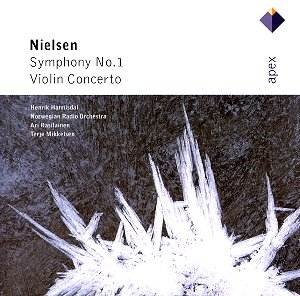The timing of writing one’s first symphony has been crucial
in the lives of many a composer, and generally those who left it as late
as possible have fared better with their first essay in the genre; at
least as a rule of thumb they have often reached their so-called mature
style by the time they write it. Nor is it only a matter of age. Brahms,
Mahler and Sibelius come to mind as examples of their first and last symphonies
not being a million miles apart; Beethoven, Schubert and Bruckner where
they certainly are not. Charles Ives, Schoenberg, Webern and Stravinsky
all have early works stylistically a vast distance from what they then
wrote immediately thereafter, and Carl Nielsen is a bit like them. His
first symphony is very Brahmsian. He even took the opportunity to show
it to the master when in Vienna in the mid-1890s and received a very encouraging
response. Nielsen was 27 when his symphony appeared, no longer a student
but an experienced orchestral player, significantly under the composer/conductor
Johan Svendsen, whose two symphonies have also just appeared on the Teldec
Apex label (0927 40621 2) with the same performers (see my current review).
The Norwegian Svendsen was in Copenhagen at the time in charge of the
Royal Chapel Orchestra, and it was he who conducted the premiere of the
first symphony in March 1894 with its composer playing among the second
violins.
By the time he came to write his Violin Concerto in
1911, his style had considerably matured (it was at the time of the
third of his six symphonies). His place in Danish music had been established
by now, much as Grieg’s had been in Norway and Sibelius’s in Finland,
but his reputation was also beginning to spread abroad. Nielsen wrote
three concertos, the others being one for the flute in 1926 and for
the clarinet in 1928. Nielsen’s indebtedness to Grieg, who had just
died in 1907, was underlined when he visited Nina Grieg, the composer’s
widow at Troldhaugen in Bergen and began writing the violin concerto
in the cabin where her husband produced his music. It was first played
by Peder Möller but later taken up by the Hungarian Emil Telmányi,
whose greater reputation did much for the work. Nielsen was less taken
with producing a note-spinning work of virtuosity, ‘I am not terribly
interested in vacuous scale passages’, nor a highly dramatic one as
Sibelius had done (both men were players of the instrument), but rather
one of a more laid-back, pastoral character.
Ari Rasilainen, conducting the Norwegian Radio Orchestra
gives the symphony not only a good sense of pace but also draws out
the kaleidoscopic moods of the first movement, to which Nielsen gives
the curious tempo indication Allegro orgoglioso, not as one might
at first sight assume to be an ‘orgiastic Allegro’ but a ‘proud’ one.
Actually it is the second movement Andante which seems to be
more inclined to such a mood with its dignified beauty, especially in
the finely taken horn solo after the climax. The third movement is gentler
than an expected scherzo (he could have learned a thing or two from
Svendsen in this regard), while the finale has plenty of dramatic fire
which Rasilainen exploits fully from his responsive orchestra.
The Violin Concerto shows just how much Nielsen’s harmonic
language had advanced in the twenty years separating it from the first
symphony, the opening slow Prelude is hardly recognisable as the same
composer. Henrik Hannisdal’s playing is sweet-toned especially in the
higher positions on the E string, bringing a Bruch like quality to the
music, and in the more virtuosic passages rather surprisingly evokes
Mediterranean tone colours. Just before the Allegro cavalleresco
breaks out (another quirky tempo indication meaning ‘knightly’ or
‘noble’), there is a repetitive motif rhythmically reminiscent of Elgar’s
Enigma theme - now there’s a thought. Hannisdal always plays
within himself, but there are some moments of suspect intonation in
the tricky cadenza. He’s at his best in the charming finale.
Christopher Fifield
|

